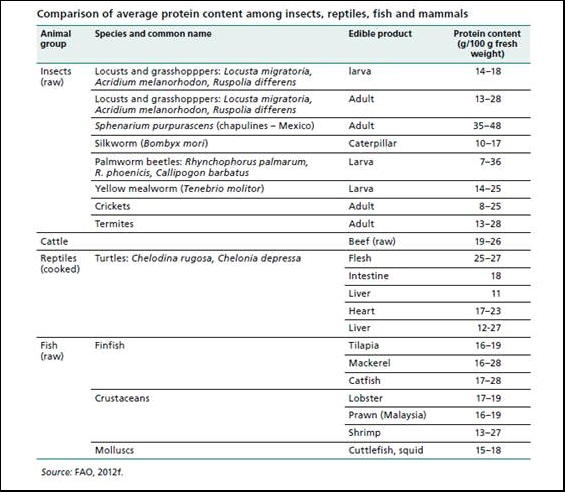Nutrition
 The nutritional value of insects does not differ from the nutritional value of other meat sources such as chicken, beef, pork and fish. In fact protein levels are often higher in insects and crude protein content in many species is above 60%. The chitin exoskeleton comprises only a small part of the total biomass (<10%) and can even be digested. Chitinase has been found in human gastric juices. Recent studies have demonstrated that chitin has even complex and size-dependent effects on innate and adaptive immune responses. The nutritional value of insects does not differ from the nutritional value of other meat sources such as chicken, beef, pork and fish. In fact protein levels are often higher in insects and crude protein content in many species is above 60%. The chitin exoskeleton comprises only a small part of the total biomass (<10%) and can even be digested. Chitinase has been found in human gastric juices. Recent studies have demonstrated that chitin has even complex and size-dependent effects on innate and adaptive immune responses.
The nutritional values of edible insects are highly variable, not least because of the wide variety of species. Even within the same group of edible insect species, values may differ depending on the metamorphic stage of the insect (in particular, for species with a complete metamorphosis – known as holometabolous species – such as ants, bees and beetles), and their habitat and diet. Like most foods, preparation and processing methods (e.g. drying, boiling or frying) applied before consumption will also influence nutritional composition. A mixed diet of a staple food and certain insect species enhance protein quality because of supplementation effects. FAO is currently compiling the nutritional value of insects in the INFOODS database for biodiversity, we encourage researchers and institutions to submit their data to the INFOODS database in order to strengthen data quality http://www.fao.org/infoods/infoods/standards-guidelines/en/order . In order to ensure reliability, validity and accuracy of the dataset, we further encourage to take the e-learning course on food composition data http://www.fao.org/infoods/infoods/training/en/ The main components of insects are fat, proteins, fatty acids, fibres, dietary minerals and vitamins. Rumpold and Schlüter (2013) compiled nutrient compositions for 236 edible insects, as published in the literature (based on dry matter). Although significant variation was found in the data, many edible insects provide satisfactory amounts of energy and protein, meet amino acid requirements for humans, are high in monounsaturated and/or polyunsaturated fatty acids, and are rich in micronutrients such as copper, iron, magnesium, manganese, phosphorous, selenium and zinc, as well as riboflavin, pantothenic acid, biotin and, in some cases, folic acid. For more information on the nutritional value of insects, please see Chapter 6 in Edible insects; Future prospects for food and feed security (http://www.fao.org/docrep/018/i3253e/i3253e.pdf)
 Source: FAO.2012f. Composition database for Biodiversity Version 2, BioFoodComp2. For more information see: http://www.fao.org/infoods/infoods/tables-and-databases/en/ Source: FAO.2012f. Composition database for Biodiversity Version 2, BioFoodComp2. For more information see: http://www.fao.org/infoods/infoods/tables-and-databases/en/
|